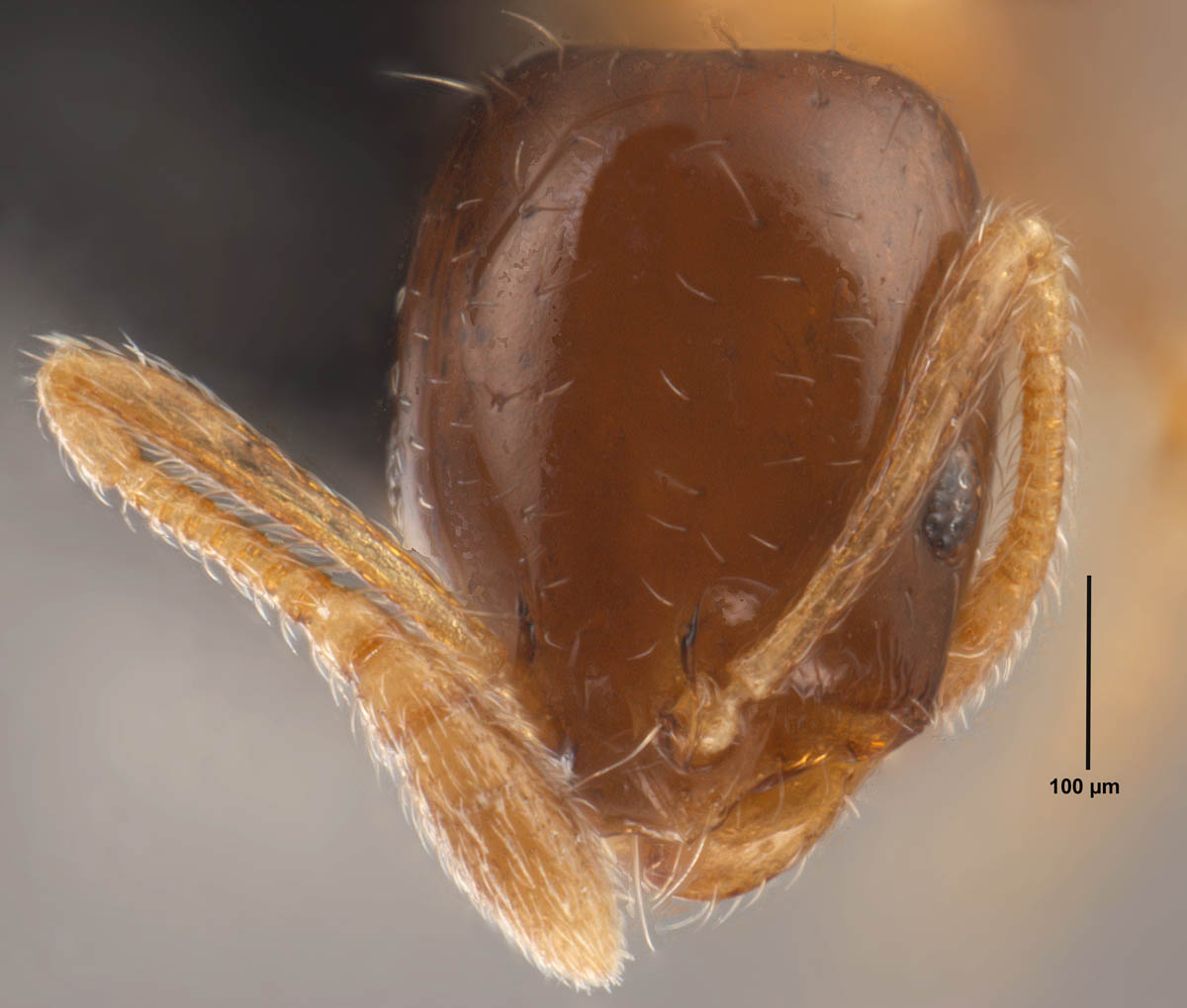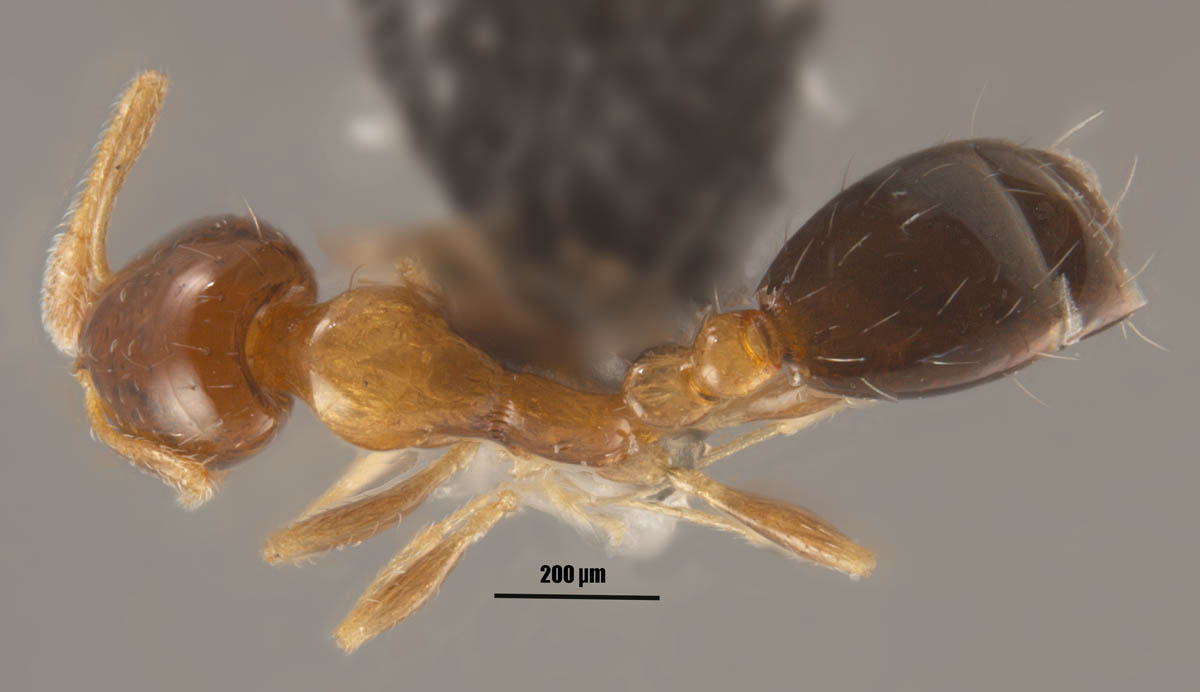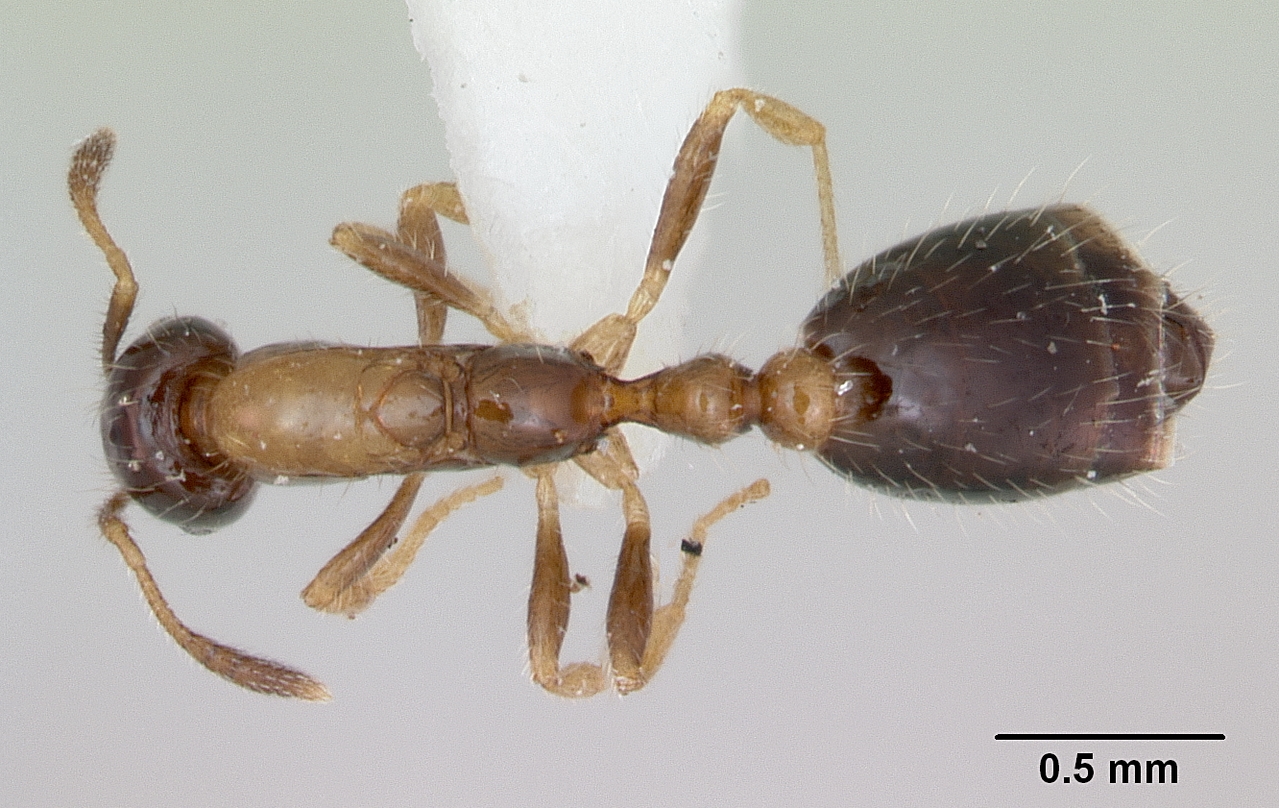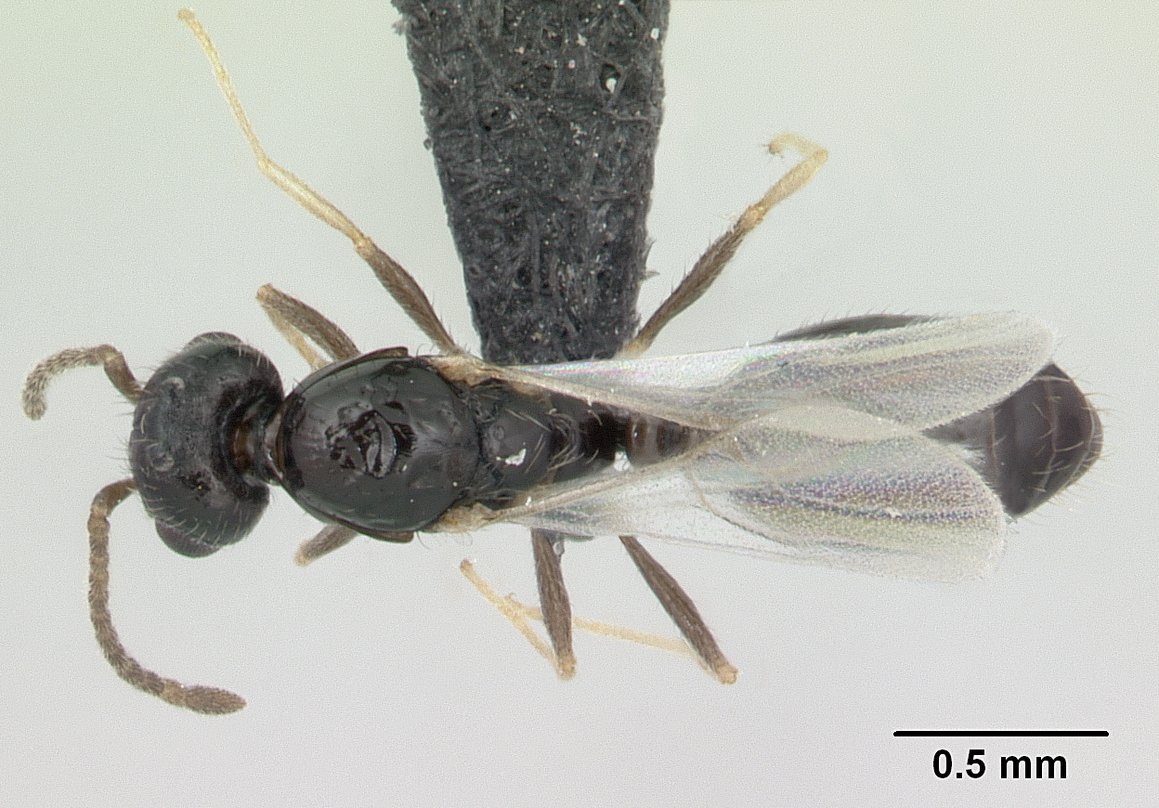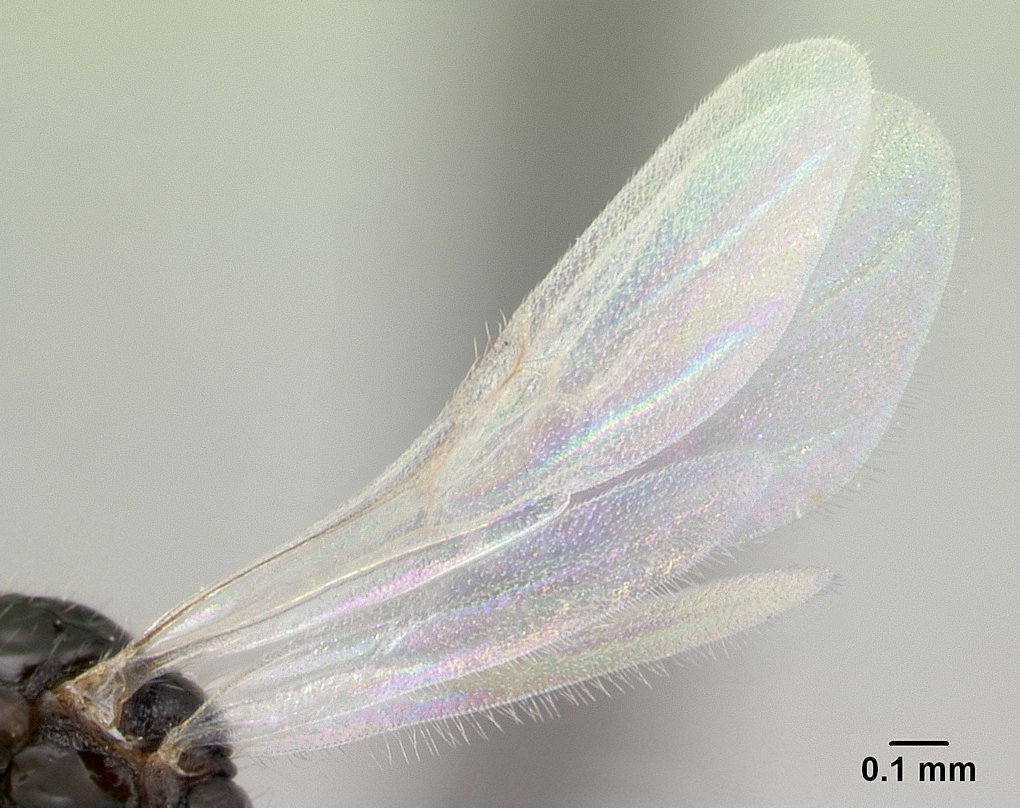Subfamily MYRMICINAE Bicolored trailing ant Authors: Joe A. MacGown and Ryan J. Whitehouse |
||
Monomorium floricola, full face view of a worker (Alachua Co., FL) (photo by Ryan J. Whitehouse and Joe A. MacGown) |
Monomorium floricola, lateral view of a worker (Alachua Co., FL) (photo by Ryan J. Whitehouse and Joe A. MacGown) |
Monomorium floricola, dorsal view of a worker (Alachua Co., FL) (photo by Ryan J. Whitehouse and Joe A. MacGown) |
Monomorium floricola, full face view of a queen (Ecuador) (photo by Antweb.org) |
Monomorium floricola, lateral view of a queen (Ecuador) (photo by Antweb.org) |
Monomorium floricola, dorsal view of a queen (Ecuador) (photo by Antweb.org) |
Monomorium floricola, full face view of a male (Mayotte) (photo by Antweb.org) |
Monomorium floricola, lateral view of a male (Mayotte) (photo by Antweb.org) |
Monomorium floricola, dorsal view of a male (Mayotte) (photo by Antweb.org) |
Monomorium floricola, lateral view of wings of a male (Mayotte) (photo by Antweb.org) |
||
Introduction Monomorium species can be identified by the presence of a petiole and post-petiole, 12 segmented antennae with a three segmented club, a raised medial area on the clypeus with fine longitudinal ridges and the lack of propodeal armament. Monomorium floricola (Jerdon) (Myrmicinae), the bicolored trailing ant, is a minute, bicolored widely distributed tramp ant thought to be native to the Old World (possibly Asia). In the US, outdoor populations are only know to occur in Florida, coastal Alabama, and coastal Mississippi. Occasionally, populations are found in heated buildings such as greenhouses in temperate regions of both Europe and the US. Taxonomic History (Bolton 2016) Diagnosis Identification Queen:(Description from Heterick 2006 and Antweb.org photos). Small, larger than worker (HL 0.66–0.68 mm, HW 0.62–0.63 mm, SL 0.58–0.62mm PW 0.52–0.73 mm) (n=2, measurements from Heterick 2006). Head, mesosoma, waist and appendages orangish yellow to orangish brown with mesoscutum and legs sometimes lighter, and dark brownish black coloration at posterior region of mesoscutellum; and gaster with orangish yellow at base of first tergite and posterior edges of tergites, with remainder dark brown to brownish black. Head slightly longer than wide, with fine reticulation posteriorally, and becoming strialate below eye level, clypeus mostly smooth and shining; entire head with numerous (but not dense) short, slightly appressed setae; eyes large, located near midline of head in side view; three ocelli present; mandibles with strong apical tooth followed by three shorter teeth of about equal size; antenna 12-segmented with 3-segmented club, scape length slightly less than head length, with appressed setae. Mesosoma thickened; mesoscutum rounded anteriorly then flattened; propodeum rounded, declivity much longer than dorsum, lacking adornment; entire mesosoma opaque, with fine foveolate sculpure limited to lower propodeal region; mesosomal dorsum with numerous short, erect setae. Waist two segmented, with dense, fine punctulate sculpture and a few long, erect setae; petiole conical in side view, pedunculate, rounded dorsally, somewhat concave anteriorly; postpetiole rounded in lateral and dorsal views. Gaster notched on anterior part of first tergite; entire gaster smooth, somewhat opaque with very fine microsculpture; numerous erect setae present; sting not conspicuous. Male: (Description from Heterick 2006 and Antweb.org photos). Small, about the size of worker (HL 0.46 mm, HW 0.50 mm, SL 0.16mm, PW 0.44 mm) (n=1) (measurements from Heterick 2006). Head, mesosoma, waist, and gaster dark brown; antennae, coxae, and femora brown; tibiae and tarsi pale yellowish brown. Head slightly wider than long; smooth and shiny posteriorly, then with longitudinal striae beginning at near the posterior-most point of eye; scattered, somewhat stout, whitish setae present. eyes large, about half the head length; ocelli prominent, slightly raised; antenna 13-segmented (including scapes); scape about length of funicular segments 2+3; mandibles falcate, with three small teeth apically. Mesosoma: mesoscutum rounded, broadly convex; pronotum trapezoidal; propodeal dorsum angle about 45°, declivity about 90°, unarmed; pronotum, mesoscutum, mesoscutellum, and mesopleuron shiny (except pitted sculpture on anterior portion of katepisternum and near wing bases); propodeal dorsum lacking sculpture, but with pitted sculpture laterally; mesosomal dorsum with short semi erect to erect setae directed posteriorly (not densely concentrated). Wings transparent; veins with little pigmentation, distal segments reduced to vestigial lines; m–cu absent; cu–a absent. Waist two-segmented, with curved setae, directed posteriorly (longer than setae on mesosoma); petiole rounded triangular in lateral view, rounded dorsally; with light sculpture anteriorolaterally and mostly smooth elsewhere; postpetiole rounded laterally and dorsally, with pitted sculpture except on dorsum. Gaster lacking sculpture, smooth and shining; with scattered short, semi erect to erect setae, especially dorsally, and with a patch of more dense, longer setae on posterior sternites; genitalia visible externally, not greatly enlarged, parameres acutely triangular. Biology and Economic Importance This species commonly infests households where it feeds on various sugary and protein rich foods (Smith 1965), and is therefore considered a minor nuisance pest. Although it has a stinger, M. floricola is not considered to be a serious stinging pest. Pest Status Distribution Australian: Australia, Cook Islands, Federated States of Micronesia, Fiji, French Polynesia, Guam, Hawaii, Indonesia, Kiribati, Marshall Islands, New Caledonia, New Guinea, Norfolk Island, Northern Mariana Islands, Palau, Samoa, Solomon Islands, Tokelau, Tonga, Vanuatu, Wallis and Fortuna Islands (AntWiki.org). U.S. Distribution: AL, FL, HI, MS (MEM). Acknowledgments Literature Cited Bolton, B. 2016. Bolton World Catalog Ants. Available online: http://www.antweb.org/world.jsp. Accessed 9 March 2016. Crawley, W. C. 1920. A gynandromorph of Monomorium floricola, Jerd. Entomologist's Record and Journal of Variation 32:217-218. Donisthorpe, H. 1914. Myrmecophilous notes for 1913. Entomologist's Record and Journal of Variation 26:37-45. Emery, C. 1894. Studi sulle formiche della fauna neotropica. VI-XVI. Bullettino della Società Entomologica Italiana 26:137-241. Forel, A. 1893. Formicides de l'Antille St. Vincent, récoltées par Mons. H. H. Smith. Transactions of the Entomological Society of London 1893:333-418. Heterick, B. 2006. A revision of the Malagasy ants belonging to genus Monomorium Mayr, 1855 (Hymenoptera: Formicidae). Proceedings of the California Academy of Sciences (4) 57:69-202. Linsley, E. G.; Usinger, R. L. 1966. Insects of the Galápagos Islands. Proceedings of the California Academy of Sciences (4)33:113-196. Mayr, G. 1879. Beiträge zur Ameisen-Fauna Asiens. Verhandlungen der Kaiserlich-Königlichen Zoologisch-Botanischen Gesellschaft in Wien 28:645-686. Smith, M.R. 1965. House-infesting ants of the Eastern United States, Their Recognition, Biology, and Economic Importance. Agricultural Research Service, United States Department of Agriculture Technical Bulletin No. 1326. Snelling, R. R. 2005: Wasps, ants, and bees: aculeate Hymenoptera. In: Lazell, J. (Ed.): Island: fact and theory in nature. University of California Press, Berkeley, CA, pp. 283-296. Wetterer, J.K. 2010. Worldwide spread if the flower ant, Monomorium floricola (Hymenoptera: Formicidae). Myrmecological News 13, 19-27. Wheeler, G. C.; Wheeler, J. 1955. The ant larvae of the myrmicine tribe Solenopsidini. American Midland Naturalist 54:119-141. Wheeler, W. M. 1905. The ants of the Bahamas, with a list of the known West Indian species. Bulletin of the American Museum of Natural History 21:79-135. Wheeler, W. M. 1913. The ants of Cuba. Bulletin of the Museum of Comparative Zoology 54:477-505. Links |
||


